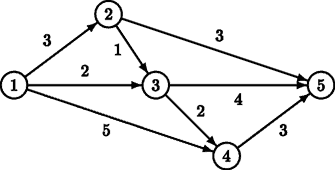@Chilling
2017-04-21T13:18:15.000000Z
字数 4250
阅读 1336
POJ-3463: Sightseeing (最短路次短路及条数)
最短路
Description
Tour operator Your Personal Holiday organises guided bus trips across the Benelux. Every day the bus moves from one city S to another city F. On this way, the tourists in the bus can see the sights alongside the route travelled. Moreover, the bus makes a number of stops (zero or more) at some beautiful cities, where the tourists get out to see the local sights.
Different groups of tourists may have different preferences for the sights they want to see, and thus for the route to be taken from S to F. Therefore, Your Personal Holiday wants to offer its clients a choice from many different routes. As hotels have been booked in advance, the starting city S and the final city F, though, are fixed. Two routes from S to F are considered different if there is at least one road from a city A to a city B which is part of one route, but not of the other route.
There is a restriction on the routes that the tourists may choose from. To leave enough time for the sightseeing at the stops (and to avoid using too much fuel), the bus has to take a short route from S to F. It has to be either a route with minimal distance, or a route which is one distance unit longer than the minimal distance. Indeed, by allowing routes that are one distance unit longer, the tourists may have more choice than by restricting them to exactly the minimal routes. This enhances the impression of a personal holiday.

For example, for the above road map, there are two minimal routes from S = 1 to F = 5: 1 → 2 → 5 and 1 → 3 → 5, both of length 6. There is one route that is one distance unit longer: 1 → 3 → 4 → 5, of length 7.
Now, given a (partial) road map of the Benelux and two cities S and F, tour operator Your Personal Holiday likes to know how many different routes it can offer to its clients, under the above restriction on the route length.
Input
The first line of the input file contains a single number: the number of test cases to follow. Each test case has the following format:
One line with two integers N and M, separated by a single space, with 2 ≤ N ≤ 1,000 and 1 ≤ M ≤ 10, 000: the number of cities and the number of roads in the road map.
M lines, each with three integers A, B and L, separated by single spaces, with 1 ≤ A, B ≤ N, A ≠ B and 1 ≤ L ≤ 1,000, describing a road from city A to city B with length L.
The roads are unidirectional. Hence, if there is a road from A to B, then there is not necessarily also a road from B to A. There may be different roads from a city A to a city B.
One line with two integers S and F, separated by a single space, with 1 ≤ S, F ≤ N and S ≠ F: the starting city and the final city of the route.
There will be at least one route from S to F.
Output
For every test case in the input file, the output should contain a single number, on a single line: the number of routes of minimal length or one distance unit longer. Test cases are such, that this number is at most .
Sample Input
2
5 8
1 2 3
1 3 2
1 4 5
2 3 1
2 5 3
3 4 2
3 5 4
4 5 3
1 5
5 6
2 3 1
3 2 1
3 1 10
4 5 2
5 2 7
5 2 7
4 1
Sample Output
3
2
题意: t组数据,每组输入点n和边m个数,输入m条边,再输入起点ST和终点EN,求从ST到EN最短路和比最短路长1的路的总条数。
#include<queue>#include<stdio.h>#include<string.h>#define INF 0x3f3f3f3fusing namespace std;const int maxn=1005;int n,m;int ST,EN;int num,pos[maxn];int vis[maxn][2];int cnt[maxn][2],dis[maxn][2];struct node1{int en,val,next;node1(int en=0,int val=0,int next=0):en(en),val(val),next(next){}}E[maxn*10];struct node{int id,val;int flag; //最短/次短node(int id=0,int val=0,int flag=0):id(id),val(val),flag(flag){}friend bool operator <(node x,node y){return x.val>y.val;}};void add(int st,int en,int val){E[num]=node1(en,val,pos[st]);pos[st]=num++;}void dij(){dis[ST][0]=0;cnt[ST][0]=1;priority_queue<node>q;q.push(node(ST,0,0));while(!q.empty()){node now=q.top();q.pop();int val=now.val;int u=now.id;int flag=now.flag;if(vis[u][flag]) continue;vis[u][flag]=1;for(int i=pos[u];i!=-1;i=E[i].next){int v=E[i].en;int newlen=val+E[i].val;if(newlen<dis[v][0]) //新路径比原最短路更小{if(dis[v][0]!=INF) //如果当前点的最短路曾更新过{ //那么不仅更新最短,也要更新次短dis[v][1]=dis[v][0];cnt[v][1]=cnt[v][0]; //次短路条数等于原来的最短路条数q.push(node(v,dis[v][1],1)); //入队,当前点距离更新,之后的也会更新}dis[v][0]=newlen; //否则仅更新最短路cnt[v][0]=cnt[u][flag];//更新最短路条数,最短路条数由u点得到,u点状态由flag标记q.push(node(v,newlen,0));}else if(newlen==dis[v][0])cnt[v][0]+=cnt[u][flag]; //增加最短路条数else if(newlen==dis[v][1])cnt[v][1]+=cnt[u][flag]; //增加次短路条数else if(newlen<dis[v][1]) //新路径大于最短路,但是小于次短路,更新次短路{dis[v][1]=newlen;cnt[v][1]=cnt[u][flag]; //次短路条数由u点得q.push(node(v,dis[v][1],1));}}}}void init(){num=0;memset(cnt,0,sizeof(cnt));memset(vis,0,sizeof(vis));memset(E,0,sizeof(E));memset(pos,-1,sizeof(pos));memset(dis,0x3f,sizeof(dis));}int main(){int t;int x,y,z;scanf("%d",&t);while(t--){init();scanf("%d%d",&n,&m);while(m--){scanf("%d%d%d",&x,&y,&z);add(x,y,z);}scanf("%d%d",&ST,&EN);dij();int ans=dis[EN][0]+1==dis[EN][1]?cnt[EN][0]+cnt[EN][1]:cnt[EN][0];printf("%d\n",ans);}return 0;}
